 The Cass Transportation Index report is a monthly report on the overall North American freight volumes and expenditures. Thousands subscribe to this report to understand what these measurements mean for their industry. Even the Bureau of Transportation Statistics has come to rely on this data.
The Cass Transportation Index report is a monthly report on the overall North American freight volumes and expenditures. Thousands subscribe to this report to understand what these measurements mean for their industry. Even the Bureau of Transportation Statistics has come to rely on this data.
If you are new to the trucking industry, you may have heard of this report without realizing its importance. That is why we compiled this short guide to the Cass Transportation indices and the Cass Transportation Index report. We explore what they are, what they measure, and what they can do for you.
What the Cass Transportation Index Measures
To understand what a Cass Transportation Index report is, how it works, and why it matters, let’s first look at where it comes from. The report is based on specific indices, composite statistics compiled from data at Cass Information Systems.
Cass Information Systems is an automated payment systems provider and one of the largest invoice processors for freight bills in the U.S. transport industry. This gives Cass access to data, which it uses to measure freight transportation through various indices.
The Indices Used by Cass Information Systems
There are different Cass Transportation Indexes:
- The Cass Freight Index measures North American monthly freight expenditures and volumes to provide an aggregate of U.S. freight deliveries.
- The Cass Truckload Linehaul Index indicates market fluctuations in per-mile truckload pricing.
- The Cass Intermodal Price Index tracks changes in U.S. domestic intermodal costs.
A Cass Transportation Index report offers in-depth analysis and forecasting for a range of US freight measures, including the indexes listed above.

A Measure of North American Freight Shipments and Volumes
A Cass Transportation Index report provides you with a snapshot of North American freight volumes. Knowing how your business compares to how others are faring in the industry speaks volumes too.
When you’re moving freight, either across the state or across the country, you’re doing more than just hauling cargo. You’re playing your part in the greater North American freight shipping sector. And what happens across the sector affects your business.
The report gives insights into freight trends, plus their relation to relevant supply chain indicators and the wider economy. And it does so by examining all the data obtained from the Cass Transportation Index.
How the Index Works
Cass Information Systems uses data from its entire Cass client base. This includes freight shipped by all modes of domestic transport. But truck hauls make up more than three-quarters of domestic freight shipping activity.
They examine all intra-continental freight shipments, including those of raw materials and finished goods, to produce each index. The monthly Cass Transportation Index report is based on the various Cass Transportation indices.
The data in each report represents the month in which the invoices for those transactions are processed by Cass. The data does not necessarily correlate with the month when those freight shipments took place. The Index point for each subsequent month represents the latest volume in relation to the baseline.

Why You Need the Freight Market Data in a Cass Transportation Index Report
A trucking industry forecast will help you understand regulatory changes, new technologies, and other factors impacting the trucking industry. But a Cass Transportation Index report can help you to better understand the freight transportation industry’s highs and lows.
Although there are other data and index providers, the Cass Transportation Index report is one of the most widely used. It has been trusted by the transportation industry for years, and can make a big difference to your business.
Still on the fence? Here are the top three reasons why you need the freight market data and insights in the monthly Cass reports.
1. Comprehensive Data for All Types of Freight Haul
Whatever you’re hauling, you’ll find information relevant to you in a Cass Transportation index report. Of course, freight shipping is a very broad category indeed. Fortunately, the Cass client base is very broad.
It contains large shippers moving everything from food, automotive parts, and consumer packaged goods to chemicals, medical supplies, and more. That is how Cass indices give those in the trucking industry a comprehensive view of what’s happening in the overall freight market.
2. Monthly Comparisons for Tracking Developing Trends
The reports offer an ongoing monthly comparison to identify developing freight shipping market trends. Whatever the size of your trucking business, you’ll find this information useful. These trends can affect the demand for, and costs involved in, your cargo hauling services.
The expenditures component will give you an idea of how your freight shipping costs compare to the costs experienced in the rest of the freight shipping industry. Each month’s volume data will show you how much the general demand for freight haulage in North America is either increasing or decreasing.

3. Better Decision Making
Running a trucking business can be challenging, from creating the best marketing strategies for your trucking business to getting the best insurance and negotiating prices. You are constantly looking for relevant market data and insights for inspiration and guidance.
If you are involved in trucking and hauling, the Cass report is yet another invaluable tool to add to the list. Best of all, you don’t have to do hours of painstaking research. All that you have to do is access and read the report. Everything you need to know is already analyzed and broken down for you.
By observing and understanding monthly trends in the freight and supply chain sector, you are empowered to make better, data-driven business decisions. You can also look back on key points in previous years’ Cass reports to see how the freight shipping business is evolving.
Indexes Related to the Cass Freight Index
Of all the Cass indices, the Cass Freight Index, in particular, receives a lot of attention. It covers a diverse range of shippers and the aggregate volume of their transactions, for an overall view of North American shipping activity.
It is not only relevant to those in the trucking industry, but to all modes of domestic freight transportation.
On its own, it offers key information about the state of the freight shipping industry. But when examined alongside the related indices, it can give you even more crucial data for a full picture of the health of the freight industry.
Cass Truckload Linehaul Index
Some indices related to the freight index are more relevant to truckers than others. The Cass Truckload Linehaul Index, for example, measures fluctuations in U.S. domestic baseline truckload costs, specifically focusing on the linehaul component (movement of freight over long distances).

Cass Intermodal Price Index
Other indices are relevant to everyone involved in freight and shipping. The Cass Intermodal Price Index carries great insights into costs. But unlike the Truckload Linehaul Index, it tracks all costs for intermodal freight (cargo in shipping containers transferred between varying modes of transportation).
Freight Index vs. Passenger Index vs. Combined Index
The Cass Transportation Index report is taken seriously by the U.S. Department of Transportation’s Bureau of Transportation Statistics (BTS), too. This government bureau looks at the Cass Freight Index data, as well as data from the Dow Transportation Index and Transportation Services Index (TSI).
The Cass Freight Index measures shipment volumes and freight expenditures based on all freight transactions processed by Cass Information Systems. The Transportation Services Index measures the volume of passengers and freight moved.
BTS uses the data to create three indices: one for passengers, one for freight, and one that combines the two.
The Dow Transportation Index is more of a measure of how investors view the profitability of the transportation industry. The other indices measure freight shipments more directly. Together, these indices and statistics allow BTS to assess the economy’s demands for moving freight and passengers.
Conclusion
The Cass Transportation Index report provides accurate and relevant freight market data. The freight rates allow you to assess demand for your services. And the freight shipping costs allow you to determine your projected costs.
So, what’s next? Perhaps you want to take advantage of increased demand for your services by adding to your fleet. Maybe you need help with unexpected truck repair costs to get back on the road again. Whatever the case, Mission Financial Services is here for you. Contact us today.


























